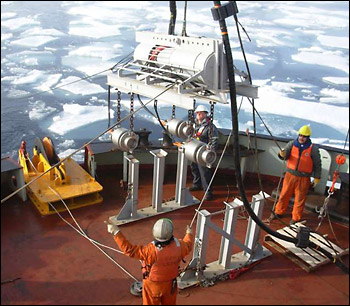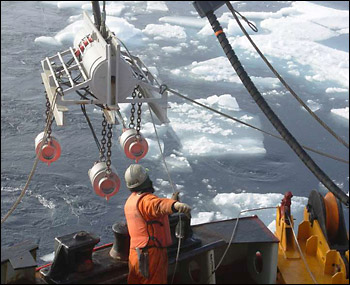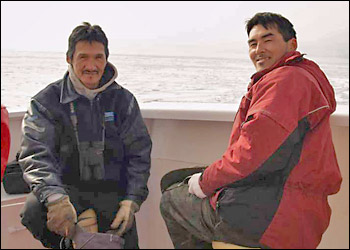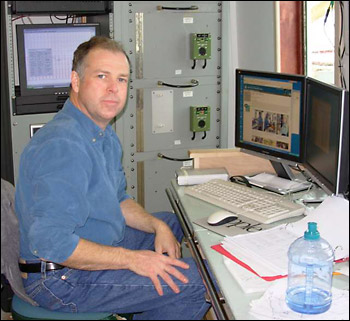Please note: You are viewing
the unstyled version of this website. Either your browser does not support CSS
(cascading style sheets) or it has been disabled. Skip
navigation.
Helen Drost, Institute of Ocean Sciences, CanadaAugust 10, 2006
Researchers Borden Chapman, Joe Manning and Ryan Pike from Natural Resources Canada (NRCan) and Thomas Funck from The Geological Survey of Denmark and Greenland (GEUS) have brought equipment that is designed specifically to chart the ocean floor and determine the depth of the sediment. There are unique challenges when mapping the Canadian Arctic Basin due to the thick ice. Thus a series of tests are being conducted to ensure this equipment (which is nicknamed the "tow sled") is able to withstand the harsh conditions, in preparation for an extensive survey effort beginning with the International Polar Year. Seismic data is acquired by making a loud noise and listening for the echo. The tow sled consists of an array of 3 air guns and a listening device which the NRCan and GEUS team deployed off the stern of the Louis. To get the air guns positioned at the proper depth of 35ft below the surface, the NRCan team had to add 4,350 lbs (~ 2 tons) weight to the guns. With the heavy weight and complicated network of cables and lines it can be dangerous work, but the Louis crew, NRCan and GEUS team made it look easy due to their skill and extensive safety precautions. The loud bang, repeated every 30 seconds, could be heard in the lower decks of the ship. It sounded like cannon shots! With each blast from the guns, made by the release of compressed air, a white cloud of bubbles rose to the surface behind the ship. During the first test the Captain assigned the Chief Engineer, Don Stortts, to scan the ship for any stress due to the pressure wave created by the air guns. One of the tests being conducted is to determine the actual decibel level of the blast. The NRCan and GEUS team are very sensitive to the potential impact the noise may have on Arctic marine mammals. Joe Illasia and Ian Green, the wildlife researchers on board, are stationed on the observation deck throughout the seismic trials. If they spot whales or polar bears within 1 km (about 0.7 miles) from the ship, the operation will be suspended. The first trial was a success. However, operation of the equipment through the thick multi-year ice is a challenge. Last updated: October 7, 2019 | |||||||||||||||||||||
Copyright ©2007 Woods Hole Oceanographic Institution, All Rights Reserved, Privacy Policy. | |||||||||||||||||||||






